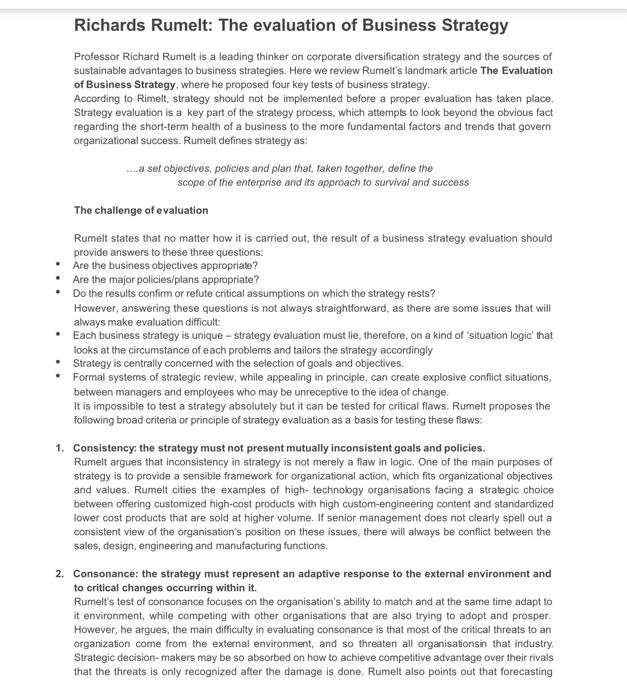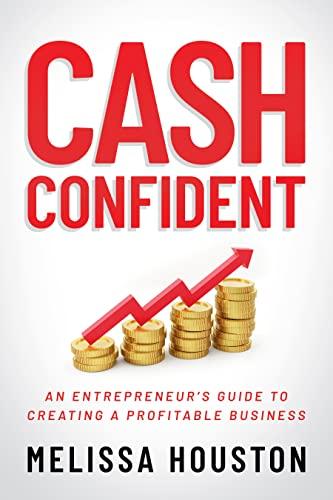Richards Rumelt: The evaluation of Business Strategy Professor Richard Rumelt is a leading thinker on corporate diversification strategy and the sources of sustainable advantages to business strategies. Here we review Rumelt's landmark article The Evaluation of Business Strategy, where he proposed four key tests of business strategy. According to Rimelt, strategy should not be implemented before a proper evaluation has taken place. Strategy evaluation is a key part of the strategy process, which attempts to look beyond the obvious fact regarding the short-term health of a business to the more fundamental factors and trends that govern organizational success. Rumelt defines strategy as: ....a set objectives, policies and plan that, taken together. define the scope of the enterprise and its approach to survival and success The challenge of evaluation Rumelt states that no matter how it is carried out, the result of a business strategy evaluation should provide answers to these three questions: Are the business objectives appropriate? Are the major policies/plans appropriate? Do the results confirm or refute critical assumptions on which the strategy rests? However, answering these questions is not always straightforward, as there are some issues that will always make evaluation difficult Each business strategy is unique - strategy evaluation must lie, therefore, on a kind of situation logic that looks at the circumstance of each problems and tailors the strategy accordingly Strategy is centrally concerned with the selection of goals and objectives. Formal systems of strategic review, while appealing in principle, can create explosive conflict situations, between managers and employees who may be unreceptive to the idea of change. It is impossible to test a strategy absolutely but it can be tested for critical flaws. Rumelt proposes the following broad criteria or principle of strategy evaluation as a basis for testing these flaws: 1. Consistency: the strategy must not present mutually inconsistent goals and policies. Rumelt argues that inconsistency in strategy is not merely a flaw in logic. One of the main purposes of strategy is to provide a sensible framework for organizational action, which fits organizational objectives and values. Rumelt cities the examples of high- technology organisations facing a strategic choice between offering customized high-cost products with high custom-engineering content and standardized Tower cost products that are sold at higher volume. If senior management does not clearly spell out a consistent view of the organisation's position on these issues, there will always be conflict between the sales, design, engineering and manufacturing functions. 2. Consonance: the strategy must represent an adaptive response to the external environment and to critical changes occurring within it. Rumelt's test of consonance focuses on the organisation's ability to match and at the same time adapt to it environment, while competing with other organisations that are also trying to adopt and prosper. However, he argues, the main difficulty in evaluating consonance is that most of the critical threats to an organization come from the external environment, and so threaten all organisationsin that industry Strategic decision-makers may be so absorbed on how to achieve competitive advantage over their rivals that the threats is only recognized after the damage is done. Rumelt also points out that forecasting Richards Rumelt: The evaluation of Business Strategy Professor Richard Rumelt is a leading thinker on corporate diversification strategy and the sources of sustainable advantages to business strategies. Here we review Rumelt's landmark article The Evaluation of Business Strategy, where he proposed four key tests of business strategy. According to Rimelt, strategy should not be implemented before a proper evaluation has taken place. Strategy evaluation is a key part of the strategy process, which attempts to look beyond the obvious fact regarding the short-term health of a business to the more fundamental factors and trends that govern organizational success. Rumelt defines strategy as: ....a set objectives, policies and plan that, taken together. define the scope of the enterprise and its approach to survival and success The challenge of evaluation Rumelt states that no matter how it is carried out, the result of a business strategy evaluation should provide answers to these three questions: Are the business objectives appropriate? Are the major policies/plans appropriate? Do the results confirm or refute critical assumptions on which the strategy rests? However, answering these questions is not always straightforward, as there are some issues that will always make evaluation difficult Each business strategy is unique - strategy evaluation must lie, therefore, on a kind of situation logic that looks at the circumstance of each problems and tailors the strategy accordingly Strategy is centrally concerned with the selection of goals and objectives. Formal systems of strategic review, while appealing in principle, can create explosive conflict situations, between managers and employees who may be unreceptive to the idea of change. It is impossible to test a strategy absolutely but it can be tested for critical flaws. Rumelt proposes the following broad criteria or principle of strategy evaluation as a basis for testing these flaws: 1. Consistency: the strategy must not present mutually inconsistent goals and policies. Rumelt argues that inconsistency in strategy is not merely a flaw in logic. One of the main purposes of strategy is to provide a sensible framework for organizational action, which fits organizational objectives and values. Rumelt cities the examples of high- technology organisations facing a strategic choice between offering customized high-cost products with high custom-engineering content and standardized Tower cost products that are sold at higher volume. If senior management does not clearly spell out a consistent view of the organisation's position on these issues, there will always be conflict between the sales, design, engineering and manufacturing functions. 2. Consonance: the strategy must represent an adaptive response to the external environment and to critical changes occurring within it. Rumelt's test of consonance focuses on the organisation's ability to match and at the same time adapt to it environment, while competing with other organisations that are also trying to adopt and prosper. However, he argues, the main difficulty in evaluating consonance is that most of the critical threats to an organization come from the external environment, and so threaten all organisationsin that industry Strategic decision-makers may be so absorbed on how to achieve competitive advantage over their rivals that the threats is only recognized after the damage is done. Rumelt also points out that forecasting







